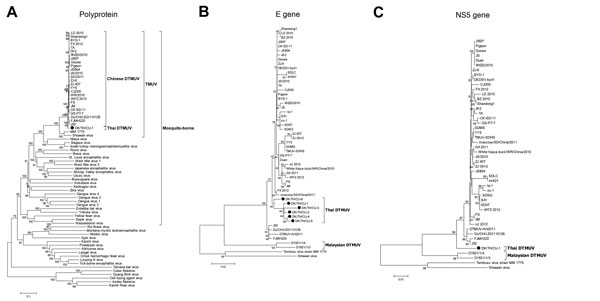Volume 21, Number 12—December 2015
Dispatch
Tembusu-Related Flavivirus in Ducks, Thailand
Figure 2

Figure 2. Phylogenetic analysis of the nucleotide sequences of polyprotein gene (10,278 bp) (A), partial envelope gene (361 bp) (B), and partial nonstructural 5 gene (900 bp) (C) of duck Tembusu viruses (DTMUVs) from ducks in Thailand and selected reference strains of flaviviruses. The nucleotide sequences were aligned by using Muscle version 3.6 (4). The phylogenetic trees were constructed in MEGA version 6.0 by using the neighbor-joining algorithm with the Kimura-2 parameter model applied to 1,000 replications of bootstrap (5). Circle indicates Thai DTMUVs. Similar results were observed when applying the maximum-likelihood algorithm (Technical Appendix
References
- Su J, Li S, Hu X, Yu X, Wang Y, Liu P, Duck egg-drop syndrome caused by BYD virus, a new Tembusu-related flavivirus. PLoS ONE. 2011;6:e18106 . DOIPubMedGoogle Scholar
- Cao Z, Zhang C, Liu Y, Ye W, Han J, Ma G, Tembusu virus in ducks, China. Emerg Infect Dis. 2011;17:1873–5 . DOIPubMedGoogle Scholar
- Homonnay ZG, Kovacs EW, Banyai K, Albert M, Feher E, Mato T, Tembusu-like flavivirus (Perak virus) as the cause of neurological disease outbreaks in young Pekin ducks. Avian Pathol. 2014;43:552–60 . DOIPubMedGoogle Scholar
- Edgar RC. MUSCLE: a multiple sequence alignment method with reduced time and space complexity. BMC Bioinformatics. 2004;5:113 . DOIPubMedGoogle Scholar
- Tamura K, Peterson D, Peterson N, Stecher G, Nei M, Kumar S. MEGA5: molecular evolutionary genetics analysis using maximum likelihood, evolutionary distance, and maximum parsimony methods. Mol Biol Evol. 2011;28:2731–9 . DOIPubMedGoogle Scholar
- O'Guinn ML, Turell MJ, Kengluecha A, Jaichapor B, Kankaew P, Miller RS, Field detection of Tembusu virus in western Thailand by RT-PCR and vector competence determination of select Culex mosquitoes for transmission of the virus. Am J Trop Med Hyg. 2013;89:1023–8 . DOIPubMedGoogle Scholar
- Tang Y, Diao Y, Yu C, Gao X, Ju X, Xue C, Characterization of a Tembusu virus isolated from naturally infected house sparrows (Passer domesticus) in northern China. Transbound Emerg Dis. 2013;60:152–8 . DOIPubMedGoogle Scholar
- Yan P, Zhao Y, Zhang X, Xu D, Dai X, Teng Q, An infectious disease of ducks caused by a newly emerged Tembusu virus strain in mainland China. Virology. 2011;417:1–8 .PubMedGoogle Scholar
- Tang Y, Gao X, Diao Y, Feng Q, Chen H, Liu X, Tembusu virus in human, China. Transbound Emerg Dis. 2013;60:193–6 . DOIPubMedGoogle Scholar
- Chen S, Wang S, Li Z, Lin F, Cheng X, Zhu X, Isolation and characterization of a Chinese strain of Tembusu virus from Hy-Line Brown layers with acute egg-drop syndrome in Fujian, China. Arch Virol. 2014;159:1099–107 . DOIPubMedGoogle Scholar
- Han K, Huang X, Li Y, Zhao D, Liu Y, Zhou X, Complete genome sequence of goose tembusu virus, isolated from jiangnan white geese in Jiangsu, China. Genome Announc. 2013;1:e0023612.PubMedGoogle Scholar
- Liu P, Lu H, Li S, Wu Y, Gao GF, Su J. Duck egg drop syndrome virus: an emerging Tembusu-related flavivirus in China. Sci China Life Sci. 2013;56:701–10.PubMedGoogle Scholar
Page created: November 17, 2015
Page updated: November 17, 2015
Page reviewed: November 17, 2015
The conclusions, findings, and opinions expressed by authors contributing to this journal do not necessarily reflect the official position of the U.S. Department of Health and Human Services, the Public Health Service, the Centers for Disease Control and Prevention, or the authors' affiliated institutions. Use of trade names is for identification only and does not imply endorsement by any of the groups named above.